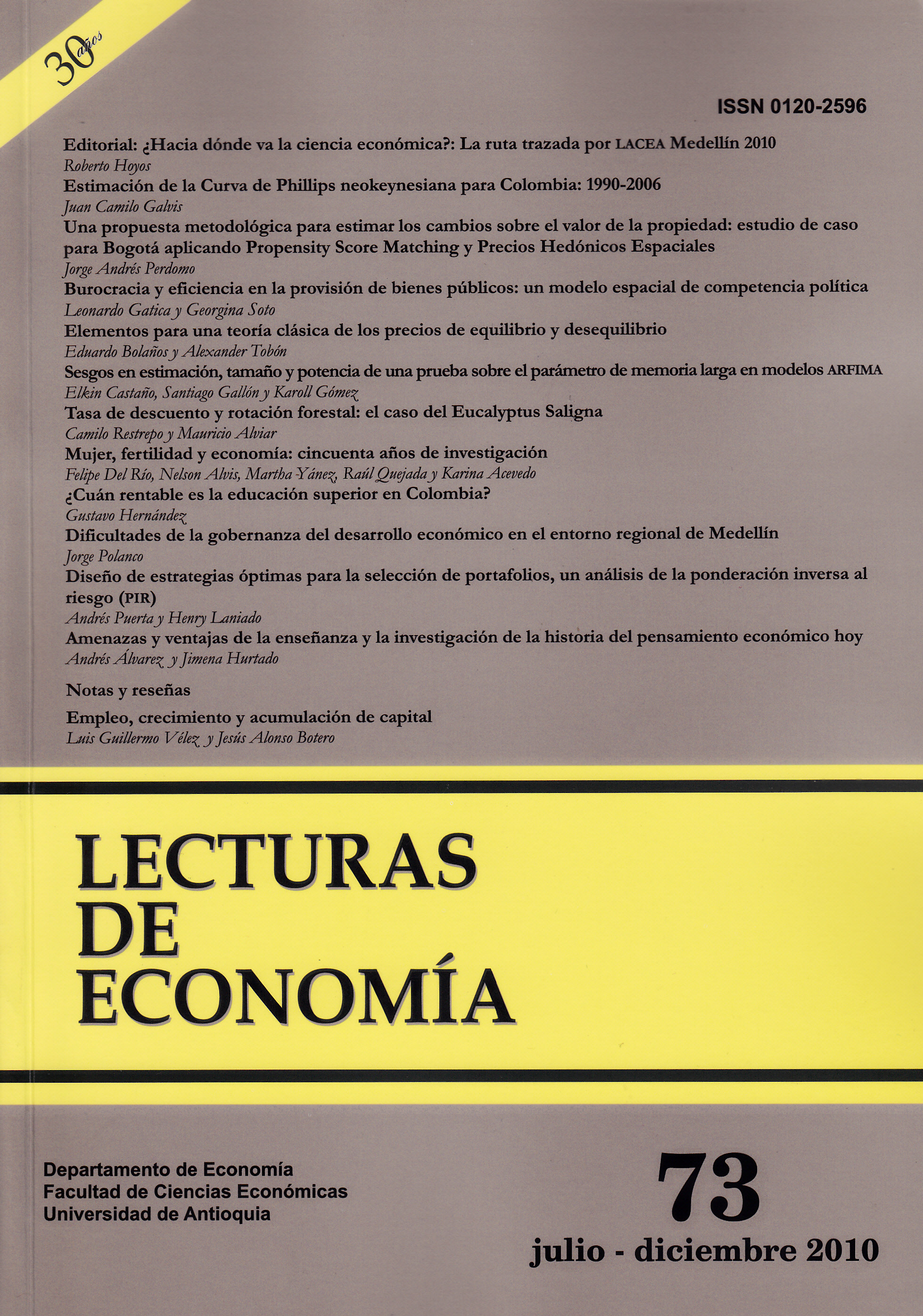Estimation Biases, Size and Power of a Test on the Long Memory Parameter in ARFIMA Models
DOI:
https://doi.org/10.17533/udea.le.n73a7867Keywords:
Hypothesis testing, time-series modelsAbstract
Castaño et al. (2008) proposed a test to investigate the existence of long memory based on the fractional differencing parameter of an ARFIMA (p, d, q) model. They showed that using an autoregressive approximation with order equal to the nearest integer of p* = T1/3 for the short-term component of this model, the test for the short memory null hypothesis against the long memory alternative hypothesis has greater power than other long memory tests, and also has an adequate size. We studied the estimation bias generated on d, and the effect on the power and size of the test when the short-term component is ignored and when the used models do not approximate it adequately. Additionally we analyze whether the obtained results by Castaño et al. (2008) can be improved employing a different autoregressive approximation.
Downloads
References
Baillie, Richard (1996). “Long Memory Processes and Fractional Integration in Econometrics,” Journal of Econometrics, No. 73, pp. 5-59.
Beran, Jan (1994). Statistics for Long-Memory Processes. Chapman & Hall/CRC, New York.
Brockwell, Peter y Davis, Richard (2006). Time Series: Theory and Methods. Second Edition, Springer-Verlag, New York.
Castaño, Elkin; Gómez, Karroll y Gallón, Santiago (2008). “Una nueva prueba para el parámetro de diferenciación fracional”, Revista Colombiana de Estadística, No. 31, pp. 67-84.
Davison, James (2007). Time Series Modelling, Version 4.24, at http://www.timeseriesmodelling.com
Davidson, James y Hashimzade, Nigar (2009). “Type I and type II Fractional Brownian Motion: A Reconsideration”, Computational Statistics and Data Analysis, No. 53, pp. 2089-2106.
Geweke, John y Porter-Hudak, Susan (1983). “The Estimation and Application of Long-Memory Time Series Models”, Journal of Time Series Analysis, No. 4, pp. 221-238.
Granger, William (1980). “Long Memory Relationships and the Aggregation of Dynamic Models”, Journal of Econometrics, No. 14, pp. 227-238.
Granger, William y Joyeux, Roseline (1980). “An Introduction to LongMemory Time Series Models and Fractional Differencing”, Journal of Time Series Analysis, No. 1, pp. 15-39.
Harris, David; McCabe, Brendan y Leybourne, Stephen (2008). “Testing for Long Memory,” forthcoming in Econometric Theory, No. 24, pp. 143-175.
Hauser, Michael (1997). “Semiparametric and Nonparametric Testing for Long Memory: A Monte Carlo Study,” Empirical Economics, No. 22, pp. 247-271.
Hosking, Jonathan (1981). “Fractional Differencing”, Biometrika, No. 68, pp. 165-176. Hurst, Harold (1951). “Long-Term Storage Capacity of Reservoirs”, Transactions of the American Society of Civil Engineers, No. 116, pp. 770-799.
Kwiatkowski, Denis; Phillips, Peter; Schmidt, Peter y Shin, Yongcheol (1992). “Testing the Null Hypothesis of Stationarity against the Alternative of a Unit Root: How Sure are we that Economic Time Series Have a Unit Root?”, Journal of Econometrics, No. 54, pp. 159-178.
Lo, Andrew (1991). Long-term Memory in Stock Market Prices, Econometrica, No. 59, pp. 1279-1313.
Lobato, Ignacio y Robinson, Peter (1998). “A Nonparametric Test for I(0)”, Review of Economic Studies, No. 65, pp. 475-495.
Robinson, Peter (1994). “Semiparametric Analysis of Long-Memory Time Series”, Annals of Statistics, No. 22, pp. 515-539.
Said, Said y Dickey, David (1984). “Testing for Unit Roots in AutoregressiveMoving Average Models of Unknown Order”, Biometrika, No. 71, pp. 599- 607.
Sowell, Fallaw (1992). “Maximum Likelihood Estimation of Stationary Univariate Fractionally Integrated Time Series Models”, Journal of Econometrics, No. 53, pp. 165-188.
Tanaka, Katsuto (1999). “The Nonstationary Fractional Unit Root”, Econometric Theory, No. 15, pp. 549-582.
Published
How to Cite
Issue
Section
License
This page, by Universidad de Antioquia, is licensed under a Creative Commons Attribution License.
Authors who publish with this journal agree to retain copyright and grant the journal right of first publication, with the article licensed under a Creative Commons Attribution-NonCommercial-ShareAlike License allowing others to share it as long as they acknowledge its authorship and original publication in this journal.
Authors can enter into separate, additional contractual arrangements for the non-exclusive distribution of the journal's published version of the work (e.g., post it to an institutional repository or publish it in a book), provided that these arrangements be not for profit and the journal be acknowledged as the original source of publication.
Authors are permitted and encouraged to post their papers online (e.g., in institutional repositories or on their websites), as it can lead to valuable exchanges as well as greater citation of the published work.







